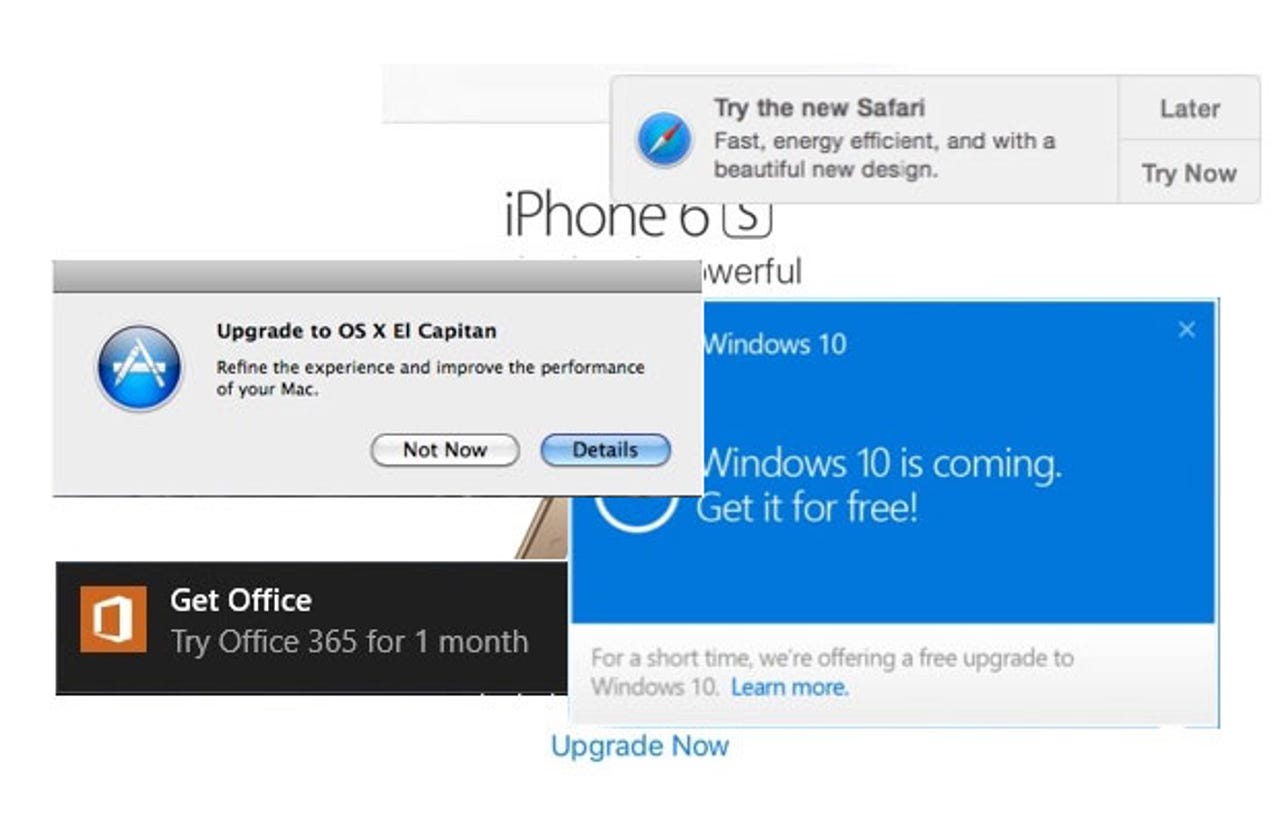2015: The year Windows, OS X and iOS became naggy and annoying


What do I remember most about 2015? I'll tell you what it is; it's the incessant nagging by Windows, OS X and iOS to upgrade to the latest version, try new services, and buy more stuff.
It's been pretty much across the board, Windows, OS X, and iOS. Nags, nags, nags ...
I'm not sure what to make to this. Are these nags the equivalent of a PSA (public service announcement) or desperation? One reminder and I'm OK with that. Two and it begins to get annoying. Three or more and I start feeling like I need to take out a restraining order.
Let me begin with the biggest nagger of 2015 - Microsoft.
The way that Microsoft has been pushing Windows 10 on users has over the course of 2015 ranged from mild prompting to aggressive harassment (although some of this was apparently down to a bad update setting). What should have been a simple operating system upgrade to Windows 10 was turned into a mess of signups, prompts and hassles.
And the only reason anyone needed to "sign up" to get Windows 10 was for the purposes of generating marketing hype.
It's an example of the sort bad things that happens when you give the marketing department a foot in the Windows Updates door.
And once you've taken the leap and moved to Windows 10 you get hassled about Office 365.
It. Never. Ends.
On top of that, Windows 10 now comes with ads. Not only do you see ads within apps - even Microsoft's own apps such as Solitaire - but there are also ads on the Start Menu. You wanted the Start Menu back? Well, you got it. Complete with ads!
As ads go, they're pretty innocuous, but it's yet another distraction that Windows users will have to get used to.
Even Apple has resorted to nags. A company that was once renowned for the beauty and simplicity of its platforms and applications has succumb to the temptation of using their platform to deliver marketing messages. I've seen nags to upgrade to El Capitan, nags to give Safari a chance, nags to sign up for Apple Music, and even nags to buy a new iPhone 6s.
Give me a break!
I find the nags that OS X spits out using the notifications center particularly irksome because they pop up where I'm expecting important information to appear. Stuff like emails and messages. Not invitations to try out Safari. I've got no interest in Safari, and I only ever use it to watch streamed Apple events or download Google Chrome. But I presume I'm going to get nagged about it on a regular basis until someone at Apple sees sense.
And that could be a long time.
Enterprise Software
You know what it all reminds me of? A child that tries to get your attention by frantically waving its arms in your face. It's the sort of distracting, annoying nonsense you expect of adware, not your operating system.
Curiously, when it comes to my Android devices, they either get upgraded automatically, or never see any upgrades. They're surprisingly nag-free, except for my Fire tablet, which is essentially one big ad for Amazon and yet the ads never feel intrusive or annoying.
If I were an optimist I'd tell you that this is a phase that will pass, but I'm more at the realist/pessimist end of the scale, and so I think that this is the tip of the iceberg. It's going to get worse over the coming months and years.
Oh, and if you're reading this Microsoft or Apple, here's how you can make things less naggy for me in 2016:
- Keep the nags to a minimum!
- If you feel the need to tell me something, give me the option to never see that message again. Don't make me have to venture into the bowels of the operating system to hack some code to make it stop.
- If you force me to interact with your nag in any way, there's a good chance it's interrupting my workflow and is annoying.
- There's no need to "sign up" in advance for operating system upgrades, free or not. That's just grade-A marketing nonsense. Doubly so when you end up later sending the operating system to people who never asked for it and don't want it.
See also:
Build the ultimate $20,000 PC
- Apple shoves annoyingly aggressive popup ads for iPhone 6s into iOS App Store app
- Don't let the 'Grinches' put you off Windows 10
- OS X 'El Capitan' finally ready for prime time - and here's how to have a trouble-free upgrade
- How to disable Windows 10 Start menu ads
- Windows 10 upgrade nags become more aggressive, offer no opt-out